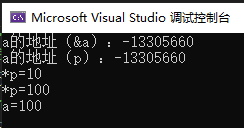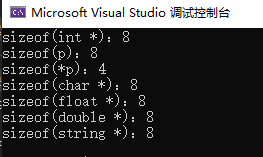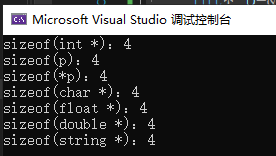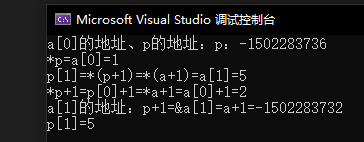1.指针的定义 2.指针的使用
如下代码:
//1.指针的定义
int a = 10;
int* p;
p = &a;//实际上是让p指向a的地址
//上面两行等价于
int* p=&a;
cout << "a的地址(&a):" << (int) & a << endl;
cout << "a的地址(p):" << (int)p << endl;
//2.指针的使用
//可以通过解引用的方式来找到指针指向的内存
//指针前面加“*”,代表解引用,找到指针指向的内存中的数据
cout << "*p=" << *p << endl;
*p = 100;//通过修改指针指向内存中的数据,修改a的值。
cout << "*p=" << *p << endl;
cout << "a=" << a << endl;
运行结果:

3.指针所占内存空间
int a = 10;
int* p=&a;
//查看指针所占内存空间的大小
cout << "sizeof(int *):" << sizeof(int *) << endl;
cout << "sizeof(p):" << sizeof(p) << endl;//与上面等价
cout << "sizeof(*p):" << sizeof(*p) << endl;//实际上是查看int所占内存空间大小
cout << "sizeof(char *):" << sizeof(char *) << endl;
cout << "sizeof(float *):" << sizeof(float *) << endl;
cout << "sizeof(double *):" << sizeof(double *) << endl;
cout << "sizeof(string *):" << sizeof(string *) << endl;
运行结果:
64位操作系统(x64)

32位操作系统(x84)

原因:指针所占内存空间大小与操作系统有关,32位4,64位为8.
其中sizeof(*p),实际上是int所占内存大小。
4.p、p+1、*p+1、※(p+1)关系
int a[3] = { 1,5,10 };
int* p = a;
cout << "a[0]的地址、p的地址:p:" << (int)p << endl;
cout << "*p=a[0]=" << *p << endl;
cout << "p[1]=*(p+1)=*(a+1)=a[1]=" << *(p + 1) << endl;
cout << "*p+1=p[0]+1=*a+1=a[0]+1=" << *p + 1 << endl;
cout << "a[1]的地址:p+1=&a[1]=a+1=" << (int)(p + 1) << endl;
cout << "p[1]=" << p[1] << endl;
运行结果:

5.p、p+1、*p+1与数组对比
https://blog.csdn.net/weixin_44190648/article/details/121889017






















 970
970











 被折叠的 条评论
为什么被折叠?
被折叠的 条评论
为什么被折叠?








